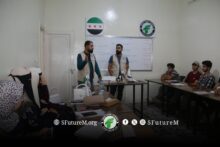Violence and Abuse against Syrian Women

Syrian Future Movement )SFM)
Family Affairs Office
Studies No. (01-09-23)
Violence or abuse against women is a serious global phenomenon that falls under the violation of women’s rights. Like other countries around the world, women in Syria suffer from various forms of violence or abuse by society. This was the case before the 2011 revolution and continued afterwards! Since we in the Syrian Future Movement are concerned with rectifying negative and aberrant conditions in our communities, it is essential to shed light on the phenomenon of violence and abuse, which is often practiced against women in Eastern societies (including Syria). Meanwhile, this phenomenon is becoming prevalent against men in most Western countries, after women benefited from the support of laws and judicial legislations, turning men into victims after they were previously accused and indicted.
Forms of Violence against Women:
Domestic Violence: Violence practiced by a family member against a woman, such as the husband, father, or brother. This includes all known and hidden forms of violence, such as beating, humiliation, threats, confinement, forced abortion, and other practices that diminish a woman’s value and deprive her of her rights. According to a study conducted by the Syrian Network for Human Rights in 2019, 67% of Syrian women experienced domestic violence in their lives, with 35% subjected to repeated or constant violence.
Sexual Violence: Violence in which the dominant party uses its power or influence to force a woman into unwanted or non-consensual sexual activity. This includes rape, harassment, early marriage, forced marriage, human trafficking, and other crimes against women. It has been documented that since March 2011, 11,523 incidents of sexual violence occurred, most of which were committed by Syrian regime forces.
Institutional Violence: Violence practiced by an official body or its equivalent against women, such as the army, security and intelligence agencies, militias, or armed organizations. This includes forms of torture, kidnapping, arbitrary detention, extrajudicial killing, and other violations of women’s rights. In 2021, 28,618 cases of women killed in Syria since March 2011 were documented, with 93 killed due to torture, while 10,628 women remain in detention, most of them by the Syrian regime forces.
Community Violence: Violence practiced by the community or part of it against women, such as family, neighbors, colleagues, or friends. This includes discrimination, bias, bullying, marginalization, and other practices that restrict a woman’s freedom. According to a study by the Syrian Network for Human Rights in 2019, 52% of Syrian women faced community violence in their lives, with 28% exposed to it constantly or repeatedly.
It can be said that violence against women in Syria is now entrenched both legally and socially for reasons that are difficult to list. The current Syrian law contains provisions that encourage or justify violence against women or mitigate its punishment, such as Article 548 of the Penal Code, which reduces the penalty for a woman’s killer if the crime was committed for “honor” reasons. The Syrian society maintains traditions and customs that undermine women’s rights and justify violence against them, as well as preferring males over females in education, work, inheritance, and marriage.
Physical violence: It is any assault that causes harm or physical injury to a woman, such as hitting, kicking, choking, stabbing, burning, or using a weapon. The perpetrator could be a husband or lover, a family member, or even a stranger.
Psychological violence: It is any behavior intended to inflict emotional harm on a woman, such as insulting her, intimidating her, controlling her, doubting her actions, belittling her, manipulating her, depriving her of money or resources, isolating her from others, or using children as a means of blackmail. The perpetrator could be a husband, boyfriend, family member, friend, or even a boss at work.
Financial violence: It is any behavior aimed at depriving a woman of her right to manage her money or possessions, or economically exploiting her. Like preventing her from working, stealing her money, forcing her to beg, destroying her property, or depriving her of education or health care. The perpetrator could be a husband, boyfriend, family member, or friend.
Political violence: It is any behavior aimed at restricting a woman’s right to participate in the political and social process. Such as preventing her from voting, running for public office, or protesting against an issue that concerns her.
This is not an exhaustive list of all forms of violence against women, as there are also other types like cultural violence, religious violence, electronic violence, and others.
Violence against women is a violation of human rights and must be combated by all possible means.
Reasons and Motivations for Violence Against Women:
Violence against women is a complex and multi-dimensional phenomenon with numerous causes ranging from social, political, economic, to psychological reasons. Broadly, some of these reasons can be summarized as follows:
Social Reasons: These are related to prevailing norms, values, and concepts in societies, which lead to gender inequality and justify control, dominance, and violence by men over women.
Political Reasons: These are connected to the role of the state, laws, and policies in protecting women’s rights and preventing violence against them, or overlooking it, or tolerating it.
Economic Reasons: These are tied to material circumstances and opportunities, such as education, employment, and income. They also relate to how poverty and unemployment increase the risk of exposure to violence.
Psychological Reasons: These relate to a child’s upbringing within the family and school and the traits and personality acquired through experiences and emotions, such as low self-esteem, stress, anger, etc.
The prolonged war in Syria and its impact on the rise of violence against women, both inside Syria and in refugee areas, is evident in the increasing rate of divorce cases, which still requires formal study and statistics.
Reports on Violence Against Women:
In a report titled: “How is Violence Against Women Institutionalized Legally and Socially in Syria?”, the history and state of Syrian law in dealing with violence against women, especially domestic violence and honor crimes, is reviewed. The report demonstrates how this law mirrors the prevailing notions and values in Syrian society, which lead to gender inequality and justification of control, dominance, and violence by men over women. It also underscores the importance of legal reform and effective implementation to safeguard and vindicate women’s rights.
In a report titled: “On the International Day for the Elimination of Violence Against Women: The Tenth Annual Report on Violations Against Females in Syria, mostly by the Syrian Regime”, the Syrian Network for Human Rights reviews the main violations committed by the conflicting parties in Syria against women from March 2011 to November 2021, according to the organization’s database. The report includes statistics on the number of female victims due to extrajudicial killing, arbitrary detention, enforced disappearance, torture, sexual violence, child recruitment, and various weapon attacks, along with accounts of certain rape cases. The report emphasizes that the majority of rape incidents were perpetrated by the forces of “Bashar al-Assad’s” regime, which employs rape as a tool for repression, terror, displacement, and demographic change.
In a report titled: “No One in Syria is Spared from Sexual Violence” from the website of the “UN Human Rights Commission”, the report draws upon the findings of the Investigation Committee in the Syrian Arab Republic. It highlights the scale, nature, and consequences of sexual violence in Syria, emphasizing that no one, regardless of their gender, age, identity, or affiliation, is exempted. The report suggests that sexual violence was deliberate, systematic, and utilized as a means of humiliation, terror, and retaliation, accompanied by a culture of denial, silence, and fear of reporting or prosecution. The report also calls for providing aid and support to victims and witnesses and holding the perpetrators accountable for these crimes.
Religions’ stance on violence against women:
In a detailed research on domestic violence and honor killings in the Muslim society by “Yaquin Foundation” for research: it discusses the history and status of violence against women in Muslim communities, whether Sunni or Shia, and shows how this violence is not based on the original sources of Islam, but on misinterpretations, outdated traditions, and political and social conditions. It also highlights the importance of renewing Islamic understanding of women’s rights and reforming the institutions that protect them.
As for Christianity, Father “Francois Aql Al-Maryami” discusses in the magazine of the Brotherhood Association, in his study titled “Christianity between Love and Violence”. He reviews the history and status of the relationship between Christianity and violence, and how, despite the basic Christian principles of love and peace, Christianity – like most other religions – has always had a violent side! He emphasizes the importance of distinguishing between the historical biases and the positive aspects of faith.
Syrian customs and traditions practiced against women:
Certainly, there are good, authentic, and ethical customs and traditions. However, here we examine the Syrian customs and traditions that involve violence against women, or in other words, a set of cultural and social practices and concepts that undermine women’s rights and dignity, and justify control, domination, and violence by men over women. Some of these customs and traditions include:
Child marriage: This is the marriage of girls below the age of maturity, occurring in some rural or impoverished areas. Causes include war and displacement. Such marriages expose these girls to physical, sexual, and psychological violence from their husbands or families, and deprive them of education and health
Honor crimes: These are killings committed by a woman’s family against her on the grounds that she betrayed her honor or the honor of her family, for reasons like being with a non-relative man, wearing immodest clothing, rejecting an arranged marriage, or being raped. These crimes are based on a mistaken concept of honor as a value related only to a woman’s behavior. There’s also a law that mitigates the punishment of a woman’s killer if he has motives of guarding “honor” in his particular understanding.
Female circumcision: This is the removal of a part of the external female genitalia, aimed at controlling their sensations and supposedly increasing their cleanliness and modesty. This occurs in some Kurdish regions in Syria due to the influence of neighboring countries, leading to severe pain, risk of bleeding, infection, and health complications for the females, in addition to violating their right to bodily and health integrity.
Of course, this isn’t an exhaustive list of all Syrian customs and traditions where men’s violence against women appears. There are also other customs like marrying divorced women to a temporary replacement (another husband) before returning to the first husband, repudiating wives by pronouncing divorce three times, temporary marriage, forced marriage, marriage for inheritance, exchange marriage, pleasure marriage, and so on! All of this is a violation of a woman’s right to choose her life partner and is a form of abuse in one way or another.
Conclusion:
In this study, we have addressed the issue of violence against women, its forms, causes, and effects, and how it represents a violation of human rights and a challenge to development and peace. We also highlighted the stance of religion on this violence and how it condemns and forbids it, advocating for the protection, honor, and kind treatment of women.
Finally, within the Syrian Future Movement, we propose some solutions and suggestions to confront this phenomenon, summarized as follows:
- Reforming the laws and policies that protect women’s rights and prevent violence against them, and effectively and comprehensively applying them.
- Raising awareness within our Syrian society about the dangers of violence against women and working to change the culture and concepts that justify or remain silent about it.
- Correcting customs and traditions that violate women’s rights, which are not based on authentic religious sources but on wrong interpretations or external influences.
- Providing assistance and support to victims of violence, whether on a health, psychological, legal, or material level.
- Enhancing the role of women in society and empowering them to exercise their rights in education, work, and participation.
Combating the phenomenon of violence against women is a shared responsibility among all segments of society, including the state, government, institutions, associations, and individuals. We cannot achieve progress and prosperity unless we preserve the dignity of half the society (in fact, the entire society) and involve them in building a better future for us and our children.
- Syrian Future Movement
- Family Affairs Office
- Researcher: Iman Al-Mohammad.





